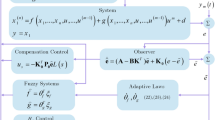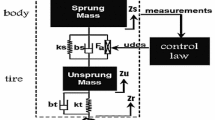Abstract
Reality shows that 1) the effectiveness of compensators for uncertainty and disturbance (UAD) depends deeply on UAD’s time varying rate (TVR), and 2) controlling a system over a network introduces different constraints and conditions, in which some of these are variable delays in control signal, packet losses, data quantization, safety, and security. This paper presents a new design of fuzzy sliding mode control (FSMC) enhanced by compensation for UAD using a disturbance observer (DO), named DO-FSMC, for a class of nonlinear systems subjected to UAD. First, in order to weaken partly the negative influence of TVR of UAD on the compensation effectiveness, we separate explicitly unidentified aspects into two groups, one related to the model error while the other coming from external disturbances, to distinctly consider. To stamp out the chattering status and reduce calculating cost, we propose an adaptive gain updated directly based on the sliding surface convergence status, to which two new control laws, one for the FSMC and the other for the DO-FSMC, are given via Lyapunov stability analysis. In order to evaluate the DO-FSMC, simulations as well as surveys based on a real semi-active suspension system using a Magnetorheological damper (MRD) with measured datasets are performed. The results obtained from the surveys coincide with the theoretical analysis which show that the competence to stamp out vibration is the advantage of the proposed method compared with the other published methods.
Similar content being viewed by others
References
S. D. Nguyen, Q. H. Nguyen, and S. B. Choi, “Hybrid clustering based fuzzy structure for vibration control–Part 1: a novel algorithm for building neuro–fuzzy system,” Mechanical Systems and Signal Processing, vol. 50–51, pp. 510–525, 2014. [click]
S. D. Nguyen, Q. H. Nguyen, and S. B. Choi, “Hybrid clustering based fuzzy structure for vibration control–Part 2: an application to semi–active vehicle seat–suspension system,” Mechanical Systems and Signal Processing, vol. 56–57, pp. 288–301, 2014.
J. Wang, A. B. Rad, and P. T. Chan, “Indirect adaptive fuzzy sliding model control–Part I: fuzzy switching,” Fuzzy Sets and Systems, vol. 122, pp. 21–30, 2001. [click]
O. Yakut and H. Alli, “Neural based sliding–mode control with moving sliding surface for the seismic isolation of structures,” J. of Vib. and Control, vol. 17, pp. 2103–2116, 2011.
X. Lingfei and Z. Yue, “Sliding–mode output feedback control for active suspension with nonlinear actuator dynamics,” Journal of Vibration and Control, vol. 21, no. 14, 2015.
H. L. Xing, D. H. Li, J. Li, and C. H. Zhang, “Linear extended state observer based sliding mode disturbance decoupling control for nonlinear multivariable systems with uncertainty,” Inter. Journal of Control, Automation and Systems, vol. 14, no. 4, pp. 967–976, 2016. [click]
R. Mado´nski and P. Herman, “Survey on methods of increasing the efficiency of extended state disturbance observers,” ISA Transactions, vol. 56, pp. 18–27, 2015. [click]
L. Wu, C. Wang, and Q. Zeng, “Observer–based sliding mode control for a class of uncertain nonlinear neutral delay systems,” Journal of the Franklin Institute, vol. 345, pp. 233–253, 2008. [click]
A. B. Sharkawy and S. A. Salman, “An adaptive fuzzy sliding mode control scheme for robotic systems,” Intel. Control and Auto., vol. 2, pp. 299–309, 2011.
S. Bououden, M. Chadli, and H. R. Karimi, “Fuzzy sliding mode controller design using Takagi–Sugeno modelled nonlinear systems,” Hindawi Publishing Corporation Mathematical Problems in Engineering, vol. 2013, Article ID 734094, p. 7, 2013.
D. Ginoya, P. D. Shendge, and S. B. Phadke, “Disturbance observer based sliding mode control of nonlinear mismatched uncertain systems,” Comm. in Nonlinear Science and Num. Simu., vol. 26, pp. 98–107, 2015.
H. Zhang, Y. Wang, and D. Liu, “Delay–dependent guaranteed cost control for uncertain stochastic fuzzy systems with multiple time delays,” IEEE Transactions on Systems Man and Cybernetics Part B–Cybernetics, vol. 38, no. 1, pp. 126–140, 2008. [click]
H. Zhang, J. Zhang, G. H. Yang, and Y. Luo, “Leader–based optimal coordination control for the consensus problem of multiagent differential games via fuzzy adaptive dynamic programming,” IEEE Tran. on Fuzzy Systems, vol. 23, no. 1, pp. 152–163, 2015. [click]
J. Yang, H. Su, Z. Li, D. Ao, and R. Song, “Adaptive control with a fuzzy tuner for cable–based rehabilitation robot,” Inter. J. of Control, Automation and Systems, vol. 14, no. 3, pp. 865–875, 2016. [click]
H. Zhang, D. Liu, Fuzzy Modeling and Fuzzy Control, Birkhäuser, Boston, 2006.
S. Yang, C. Li, and T. Huang, “Exponential stabilization and synchronization for fuzzy model of memristive neural networks by periodically intermittent control,” Neural Networks, vol. 75, pp. 162–172, 2016. [click]
S. Yang, C. Li, and T. Huang, “Impulsive synchronization for TS fuzzy model of memristor–based chaotic systems with parameter mismatches,” Inter. Journal of Control, Automation and Systems, vol. 14, no. 3, pp. 854–864, 2016. [click]
S. N. Sivanandan, S. Sumathi, and S. N. Deepa, Inductionto Fuzzy Logic Using MATLAB, Springer, Verlag Berlin Heidelberg, 2007.
O. Linda and M. Manic, “General type–2 fuzzy c–means algorithm for uncertain fuzzy clustering,” IEEE Tran. on Fuzzy Systems, vol. 20, no. 5, pp. 883–897, 2012. [click]
R. Hosseini, S. D. Qanadli, S. Barman, M. Mazinani, T. Ellis, and J. Dehmeshki, “An automatic approach for learning and tuning Gaussian interval type–2 fuzzy membership functions applied to lung CAD classification system,” IEEE Transactions on Fuzzy Systems, vol. 20, no. 2, pp. 224–234, 2012. [click]
H. F. Ho, Y. K. Wong, and A. B. Rad, “Adaptive fuzzy sliding mode control with chattering elimination for nonlinear SISO systems,” Simulation Modelling Practice and Theory, vol. 17, pp. 1199–1210, 2009. [click]
V. Nekoukar and A. Erfanian, “Adaptive fuzzy terminal sliding mode control for a class of MIMO uncertain nonlinear systems,” Fuzzy Sets and Systems, vol. 179, pp. 34–49, 2011. [click]
O. Castillo and P. Melin, “A review on the design and optimization of interval type–2 fuzzy controllers,” Applied Soft Comp., vol. 12, pp. 1267–1278, 2012. [click]
J. L. Yao and W. K. Shi, “Development of a sliding mode controller for semi–active vehicle suspensions,” J. of Vibration and Control, vol. 19, pp. 1152–1160, 2013.
B. L. Zhang, Q. L. Han, X. M. Zhang, and X. Yu, “Sliding mode control with mixed current and delayed states for offshore steel jacket platforms,” IEEE Trans. on Con. Sys. Tech., vol. 22, pp. 1769–1783, 2013. [click]
J. Song, S. Song, and H. Zhou, “Adaptive nonsingular fast terminal sliding mode guidance law with impact angle constrains,” Inter. J. of Control, Auto. and Systems, vol. 14, no. 1, pp. 99–114, 2016. [click]
H. Alli and O. Yakut, “Application of robust fuzzy slidingmode controller with fuzzy moving sliding surfaces for earthquake–excited structures,” Structural Engineering and Mechanics, vol. 26, pp. 517–544, 2007. [click]
S. Mobayen and S. Javadi, “Disturbance observer and finite–time tracker design of disturbed third–order nonholonomic systems using terminal sliding mode,” Journal of Vibration and Control, vol. 23, no. 2, 2017.
G. Milad and A. Nastaran, “Fuzzy Sliding Mode Control for applying to active vehicle suspensions,” WSEAS Tran. on Systems and Cont., vol. 5, pp. 48–57, 2010.
S. D. Nguyen and Q. H. Nguyen, “Design of active suspension controller for train cars based on sliding mode control, uncertainty observer and neuro–fuzzy system,” Journal of Vibration and Control, vol. 23, no. 8, 2017.
W. H. Chen, “Disturbance observer based control for nonlinear systems,” IEEE/ASME Transactions on Mechatronics, vol. 9, no. 4, pp. 706–710, 2004. [click]
R. Mohammad, H. Mohammad, and R. Mohammad, “An optimal and intelligent control strategy for a class of nonlinear systems: adaptive fuzzy sliding mode,” Journal of Vibration and Control, vol. 22, no. 1, 2016.
P. T. Chan, A. B. Rad, and J. Wang, “Indirect adaptive fuzzy sliding mode control: Part II: parameter projection and supervisory control,” Fuzzy Sets and Systems, vol. 122, pp. 31–43, 2001. [click]
M. A. Khanesar, O. Kaynak, S, Yin, and H. Gao, “Adaptive indirect fuzzy sliding mode controller for networked control systems subject to time–varying network–induced time delay,” IEEE Transactions on Fuzzy Systems, vol. 23, no. 1, pp. 205–214, 2015. [click]
W. H. Chen, “Nonlinear disturbance observer–enhanced Dynamic inversion control of missiles,” Journal of Guidance, Control, and Dynamics, vol. 26, no. 1, pp. 161–166, 2003. [click]
H. Li, J. Yu, C. Hilton, and H. Liu, “Adaptive sliding–mode control for nonlinear active suspension vehicle systems using T–S fuzzy approach,” IEEE Trans. on Indus. Electronics, vol. 60, no. 8, pp. 3328–3338, 2013. [click]
S. D. Nguyen and T. I. Seo, “Establishing ANFIS and the use for predicting sliding control of active railway suspension systems subjected to uncertainties and disturbances,” Inter. J. of Machine Learning and Cybernetics, Doi: 10.1007/s13042–016–0614–z, 2016.
Author information
Authors and Affiliations
Corresponding author
Additional information
Recommended by Associate Editor Sung Jin Yoo under the direction of Editor Euntai Kim. This research was supported by the Post-doctor Research Program (2016) through the Incheon National University (INU), Incheon, Korea.
Sy Dzung Nguyen received the M.E. degree in Manufacturing Engineering from Ho Chi Minh City University of Technology (HCMUT) - VNU in 2001, Ph.D. degree in Applied Mechanics in 2011 from HCMUT. He was a postdoctoral fellow at Inha University, Korea, 2011–2012, at Incheon National University, Korea, 2015–2016. He is currently a Head of Division of Computational Mechatronics, Institute for Computational Science, Ton Duc Thang University, Vietnam. His research interests include artificial intelligence and its applications to nonlinear adaptive control, system identification and managing structure damage. Dr. Nguyen has been the main author of plenty of ISI papers in these fields.
Seung-Bok Choi received the B.Sc. degree in mechanical engineering from Inha University, Korea, 1979, the M.Sc. and Ph.D. degrees from the Michigan State University, U.S.A in 1986 and 1990, respectively. He is currently a dean of graduate school of Inha University and a distinguished fellow professor of mechanical engineering at Inha University. His research interests are control applications using smart materials such as electro-rheological (ER) fluids, magneto-rheological (MR) fluids, piezoelectric materials and shape memory alloys. He has published more than 450 refereed international journal papers and two books in the area of smart materials and their applications.
Tae-il Seo received the Ph.D. Degree in mechanical engineering, Ecole Centrale de Nantes, France, in 1998. From 1998 to 1999, he was a postdoctoral research fellow in Department of Mechanical Engineering in Inha University, Incheon, Korea. From 1999 to 2001, he was a research fellow in the Department of mechanical corporation Laboratory, Inha University of Korea. From 2001 to 2003, he was a researcher in Department of Precision Mold Lab, KITECH (Korea Institute of Industrial Technology), Korea. Currently, he is a Professor in Department of Mechanical Engineering in Incheon National University, Korea. Dr. Seo’s current research interests include Micro End-Milling, Intelligent Manufacturing System, CAD/CAD systems, etc.
Rights and permissions
About this article
Cite this article
Nguyen, S.D., Choi, SB. & Seo, TI. Adaptive fuzzy sliding control enhanced by compensation for explicitly unidentified aspects. Int. J. Control Autom. Syst. 15, 2906–2920 (2017). https://doi.org/10.1007/s12555-016-0569-6
Received:
Revised:
Accepted:
Published:
Issue Date:
DOI: https://doi.org/10.1007/s12555-016-0569-6




